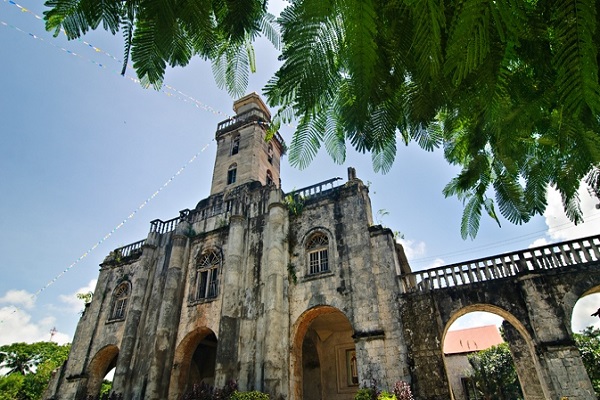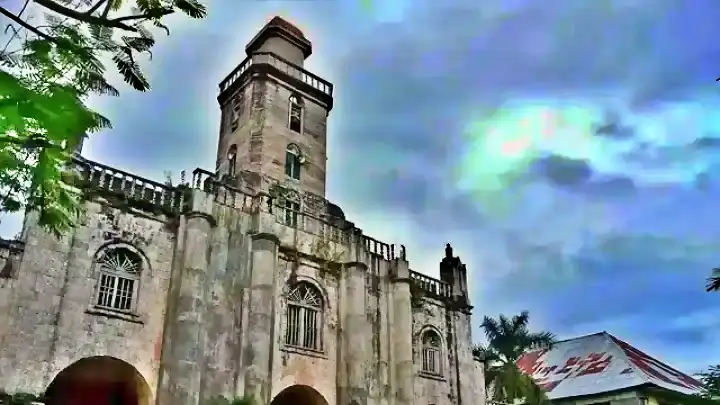⭐ BEST FERRY via CEBU & Countryside Tour: Our pick for Ferry Tickets and Countryside Tours.
- Bohol
- Bohol Attractions
- Bohol Spanish Churches
- Albuquerque Church Bohol
Alburquerque Church Bohol
The Alburquerque Church, also known as the Santa Monica Parish Church, is a significant religious and historical landmark located in the municipality of Alburquerque in Bohol, Philippines.
As a Roman Catholic church, it falls under the jurisdiction of the Diocese of Tagbilaran and holds great importance to the local community.
In recognition of its cultural significance, the National Museum of the Philippines declared it as an Important Cultural Property in 2013.
The town of Alburquerque, often referred to by locals as "Albur," is situated along the highway, and the church complex is prominently built on a low knoll, offering a picturesque setting.
The establishment of the Albur parish took place in 1869 when it was separated from the Baclayon parish in Bohol.
An 1886 report indicates that the church itself was initially constructed using light materials, while the convento (convent) adjacent to it was already built and described as "de grandes dimensiones," which translates to "of significant dimensions."
The Alburquerque Church has endured significant events throughout its history, including the devastating 7.2 magnitude earthquake that struck Bohol in 2013.
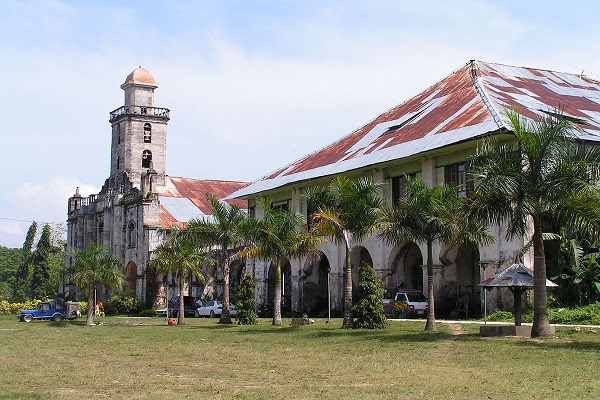
About the 2013 earthquake and the Alburquerque Church.
The history of the Sta. Monica Church is part and parcel of the historical heritage of the Alburanons. History of Alburquerque Church
The church's architecture reflects the Spanish colonial influence prevalent in many historical churches across the Philippines.
While the exact details of the original church's construction are not specified, it is likely that it underwent renovations and improvements over time to achieve its present form.
The church's exterior exhibits a blend of architectural styles, combining elements of Baroque, Neoclassical, and Earthquake Baroque design.
Ready to explore the beautiful islands of Cebu and Bohol? Secure your ferry tickets today through 12go and start your unforgettable journey!

The interior of the Alburquerque Church features a traditional cruciform layout, with a nave leading to the transept and culminating in the sanctuary.
The ceiling displays ornate decorations and intricately designed motifs, showcasing the craftsmanship of the past.
The church's altar is the focal point, adorned with religious statues and artwork that add to the spiritual ambiance of the place.
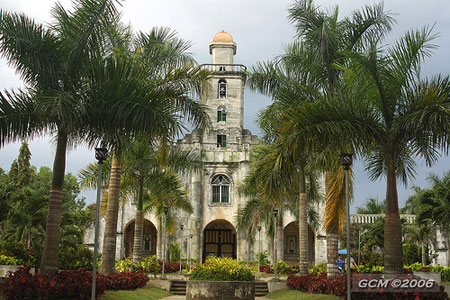
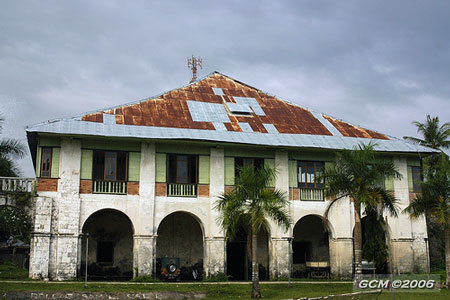
As an Important Cultural Property, the Alburquerque Church stands as a testament to the rich heritage and religious devotion of the Boholano people.
It serves not only as a place of worship but also as a historical and architectural treasure that visitors can appreciate.
Exploring the church and its surroundings offers an opportunity to delve into the region's history and experience the cultural significance of this cherished landmark in Alburquerque, Bohol.
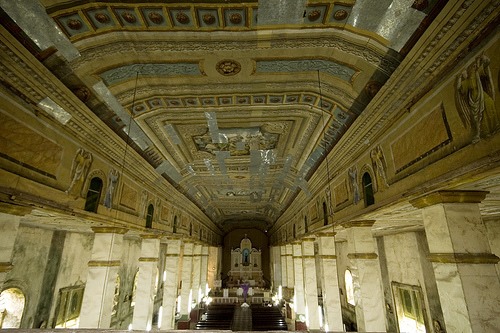 Albuquerque Church ceiling (Photo: Oggie)
Albuquerque Church ceiling (Photo: Oggie)Alburquerque Church history
The history of the Sta. Monica Church is part and parcel of the historical heritage of the Alburanons. Its inception and growth likewise portrays the life of the people of Albur. Converted to the Catholic faith by the Spaniards, the people grew in their faith and religious outpourings such as attending of Holy Masses and other religious activities became a must for them.
With Lady Mariona Irag leading the people, a chapel was established in their barangay and a priest from Baclayon came over to serve them. With the accessibility of the chapel, the faithful grew. More people, even those from other neighboring barangays, came over to attend the services.
Eventually, people from other barangays settled in Segunto to be near to the chapel and the population grew. Finally meeting the requirements of township, the town of Alburquerque was established on June 9, 1868 followed by its formal declaration into a town as to its religious jurisdiction on November, 14, 1868. Finding the faithful to have grown for it to be constituted a parish, the Bishop of Cebu canonically established Alburquerque into a separate parish from Baclayon.
To accommodate the people, the chapel was extended. Up to the 1880’s, the church was more or less like a huge shed with three aisles. The walls were only made of tabique. Shortly after being established into a parish, the construction of a much bigger church made of coral stone commenced. The convent was also constructed. Between the church and the convent, a grotto was made.
Through the years, efforts were made to improve the church. Other improvements were unfinished as can be seen by some ruins near the church. However, the tower over the façade and other upper portions of the church was completed only during the first half of the 20th century.
Three bells inscribed with the names Sta. Monica, San Augustine, and “Calipay” or Joy, respectively, hangs in the quadrangle tower. The bells are dated 1866 and so are witnesses to the growth of the parish of Alburquerque to what it is now.
http://www.alburq.gov.ph
During and After 2013 Earthquake
The Alburquerque Church has endured significant events throughout its history, including the devastating 7.2 magnitude earthquake that struck Bohol in 2013. Despite the forceful impact of the earthquake, the church miraculously sustained only minimal damage, showcasing the resilience of its construction.
Following the earthquake, the importance of preserving and safeguarding historical and cultural landmarks became evident. Recognizing the significance of the Alburquerque Church, the National Historical Institute declared it as a National Historical Landmark in 2014. This recognition further highlighted the church's historical, architectural, and cultural value, solidifying its importance in the national narrative.
In the years that followed the earthquake, efforts were made to restore and preserve the Alburquerque Church. Restoration work aimed to repair any damage incurred during the earthquake and ensure the structural integrity of the church. Skilled craftsmen and experts collaborated to meticulously restore the church, employing traditional techniques and materials to maintain its historical authenticity.
The restoration process focused on bringing the Alburquerque Church back to its original splendor while incorporating necessary modern enhancements to ensure its longevity. The restoration work aimed to retain the church's unique architectural features, intricate details, and religious symbolism, allowing visitors to appreciate its historical significance.
Today, the Alburquerque Church stands as a symbol of resilience and restoration. It serves as a testament to the dedicated efforts of the community and various organizations in preserving the cultural and architectural heritage of Bohol. As one of the few intact churches in the province after the earthquake, it serves as a poignant reminder of the region's rich history and the importance of safeguarding these cherished landmarks for future generations.
Visitors to the Alburquerque Church can now witness the meticulous restoration work that has revived its grandeur. Exploring its halls and admiring its architectural details not only offers a glimpse into the past but also fosters a deeper appreciation for the cultural legacy that the church represents. The Alburquerque Church continues to stand tall as a cherished historical treasure, inviting visitors to connect with the history, faith, and resilience of the people of Bohol.
Faith Filled Work of Art: Bohol Churches
Ready to explore the beautiful islands of Cebu and Bohol? Secure your ferry tickets today through 12go and start your unforgettable journey!
recommended hotel booking
Book your stay in Bohol's breathtaking surroundings through Agoda and experience the ultimate relaxation
Top 25 Sights and Attractions in Bohol
- Chocolate Hills
- Tarsier Conservation Sanctuary
- Panglao Island
- Loboc River Cruise
- Hinagdanan Cave
- Balicasag Island
- Alona Beach
- Bilar Man-made Forest
- Blood Compact Shrine
- Baclayon Church
- Bohol Bee Farm
- Anda Beach
- Sipatan Twin Hanging Bridge Loboc
- Danao Adventure Park
- Sagbayan Peak
- Butterfly Conservation Center
- Clarin Ancestral House
- Dimiao Twin Falls
- Mag-Aso Falls
- Anda White Beach
- Lamanok Island
- Rajah Sikatuna Protected Landscape
- Dauis Church
- Can-umantad Falls
- Punta Cruz Watchtower
All Rights Reserved ©2024. Bohol Philippines Travel Guide
Address: Talibon, Bohol, Philippines
